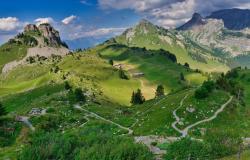The Draguignan Museum of Fine Arts is currently offering a very special exhibition with an incredible history.
Indeed, originally from the south of France, Marguerite Maeght knows the story of Saint Roseline well, whose miracles are famous in this region. She then decides to ask him for a grandson (she already has several granddaughters). Her wish granted, the collector and patron feeling indebted, called on her closest artist friends to tackle the restoration of the chapel dedicated to the saint, located in Arcs-sur-Argens. Giacometti, Chagall, Bazaine and Ubac will participate in this project and will give this building a celestial dimension.
Marguerite Maeght’s wish is presented at the Draguignan MBA until September 22.
Excerpts from the exhibition catalog
Candor Lucis
Jean Bazaine and Raoul Ubac at the Sainte-Roseline Chapel
by Marine Roux
It is through monumental art and in particular the art of stained glass that the revival of sacred art takes place, the pre-war beginnings of which are evident in the decorative program of the church on the plateau. d’Assy in Haute-Savoie, engaged in 1938-1939 and in which Jean Bazaine and Marc Chagall participated in particular. Resolutely focused on modernity, this project aroused violent controversies that the Second Vatican Council, opened in 1962, attempted to resolve. However, it opened up a new artistic path for sacred art. Consecrated in 1950, the church on the Assy plateau opens up perspectives previously closed to non-figurative artists who were asked to create numerous stained glass windows following the destruction of the Second World War. Twenty years later, the stained glass windows by Jean Bazaine and Raoul Ubac created for the Sainte-Roseline Chapel bear witness to the revival of sacred art and the personal perception they have of it. In 1970, Jean Bazaine had known the Maeght family for more than three decades and his work has been regularly presented at the eponymous Gallery since his first exhibition in 1949. He is part of this entourage of artists who have established strong bonds of friendship with the couple and the order placed on them result from this intimate setting.
At the time, Bazaine had just completed, for the Saint-Séverin church in Paris, a program of eight stained glass windows that marked a first masterpiece among his various monumental creations for religious places. It was therefore an established artist and a fervent defender of stained glass who designed, for the chapel of Les Arcs, Death and Resurrection, the creation of which was entrusted to the master glassmaker Bernard Allain and executed in his workshop in Vauhallan. The glasswork was installed in 1970 on the south side wall of the choir, to the right of the altarpiece of the high altar dating from the 17th century (…) In Bazaine’s work, what he calls “human things” and “things of the earth” are at the heart of his search for original vitality, just as in the work of his colleague and friend, Raoul Ubac. Ubac finds his inspiration in nature, better, he finds strength there. (…) The artist communes with the environment in which man grew up: stone, earth, trees and slate are both his muses and his preferred materials.
Although he has long stuck to drawing and gouache, his experiments nourish all the mediums he uses and it is in the fields of photography, sculpture, engraving and stained glass that he best plays with the contrasts of chiaroscuro. In soliciting Jean Bazaine and Raoul Ubac for her project, Marguerite Maeght certainly suspected the plastic and spiritual coherence that would be born from this duo of artists. Located in the central nave, in the south chapel and in the choir, Ubac’s stained glass windows present themselves to the eye as a route leading to the choir where Bazaine’s large stained glass window sits. The deep blue of the ones gracefully matches the fiery tones of the other. The vibratory impulses of one complement the sober and contained dynamism of the others. And there is a connection to the divine, whatever the beliefs and vision of the sacred of each artist.






